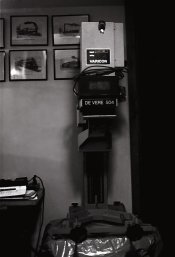Bill, With the lens carriers there should be two. One is recessed and this is used for all lenses which take the 39mm thread. In my case I decided to get the hole widened and have a machined alloy threaded piece, permanently inserted.
I run Schneider 50 and 105 Componon S lenses in this. One of the more interesting aspects of the Schneider Componon S lenses, is that their threads are placed in exactly the same position in relation to their external hardware.
This means that when the lenses are screwed in, the backlit aperture is facing the front, with the aperture blade lever situated near the left rear.
By getting the thread insert mounted in the correct position, you are always assured of having the lens in use in the best position for fast and accurate work.
Having used these enlargers in an industrial environment the lens changing saga was sometimes a pain in the rear especially when trying to unscrew a lens that was a bit tight. The other option is to have a lens carrier for each lens.
The larger flat lens carrier is for a 150mm lens, I use a retaining ring, which is standard, for this.
With the plastic hinges that the neg carrier has, I have used for close to 20 years, an old Ilford 5L fixer bottle cut up into the correct size and drilled for where the retaining screws go. These hinges are a pain to purchase, they also cost a packet. Using a sheet metal cutter is perfect for this purpose.
I would suggest that you align your neg/head stage and lens carrier with each other before attaching your base board.
If you look carefully you should see a bolt and a recessed allan key, almost alongside each other on both of these stages. They are the aligning tools you need. You undo the bolt, and then either screw in or out, the alan keyed bolt for alignment. Once aligned, you screw in the bolt and that then locks in your alignment.
The baseboard alignment can be done quite accurately with the four independent bolts in each corner. I had to fit a new baseboard to my enlarger and I had it cut so that it was 75mm longer towards the operator, this allows a 12x16" easel to be used, more or less in the portrait mode, without falling off the edge.
Is it a freestanding enlarger with the drop table?
Mick.












